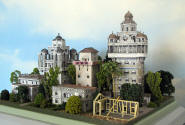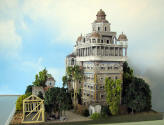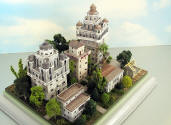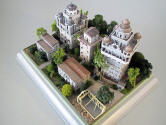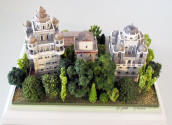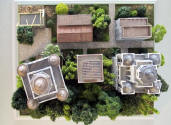|
The Diaolou of China were previously
romanticized as Clock Towers, but in reality they were fortified multi-story
watchtowers in rural villages. And they were generally made of
reinforced concrete. They were built from the time of the Ming Dynasty
to the early 20th century, reaching a peak during the Warlord Era of the
1920s. During this period there were more than 3000 Diaolou's.
Today there are approximately 1800 still standing - mostly abandoned.
They are located mainly in the KAIPING area of China and are a World
Heritage Site.
Because of poverty and social
instabilities, Kaiping was a region where emigration abroad occurred.
The Chinese living abroad and the Chinese returning with wealth acquired in
other countries funded most of the Diaolou. This explains why the tall
buildings have modern features and often include Western architectural
styles. Above all, the main towers represented a flamboyant display of
wealth.
The area of Kaiping became a melting pot of
ideas and trends brought back by the overseas Chinese. As a result the
villagers incorporated architectural features from the West. Because
of banditry, the building of defensive towers had been a local tradition in
the Kaiping area since Ming times. The Diaolou represent the
flourishing of this tradition, in which the conspicuous wealth of the
returning Chinese contributed to the spread of banditry which in return
contributed to the building of taller and taller towers. Although the
Diaolou were built mainly as protection against bandits, the majority of
them also served as living quarters and were built by a single family or by
several families together.
The mix of architectural styles that adorn
the buildings is a surprise. Some buildings have domes and arches, and
others employ Western-style columns. Many look like apartment
buildings that were built in cities in the West. The families and
clans competed with one another for prestige and power, and they competed to
build the tallest and grandest looking buildings. You can see Spanish
or Muslim domes, towers that look pagodas, and buildings with Western
architectural elements for decoration.
There are essentially three basic kinds of
towers: watch towers, fortified residential apartment dwellings, and
buildings constructed to be emergency refuges. To defend the area,
guards needed tall fortresses to use as their base and to survey the
countryside. These were the watchtowers. Clans and villages
constructed fortified residential apartment buildings that they lived in or
prepared as a refuge in case of danger or to help people escape floods.
After 1949 when a new administrative system
was initiated in China, the Diaolou lost their defensive purpose and were
abandoned or converted. It is thought that about 1,800 Diaolou remain
in the area. Some of them are only three stories high, and the tallest
is called "Ruishui Diaolou" (pictured above). It is 9 stories high,
built in 1921, and is a mix of Byzantine and Neoclassical elements.
While most of the Diaolou are abandoned and in ruins, local Chinese have
moved into some, and the Chinese Government has begun to preserve others as
a National Heritage. Tourists are allowed to visit many of them and go
upstairs. Owners of some of the private Diaolou sometimes allow
tourists to visit. |
